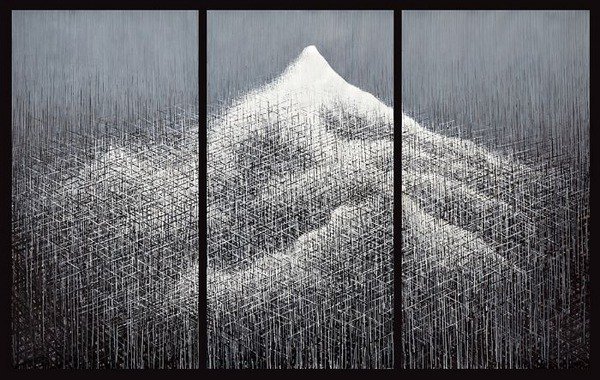Walid Siti / Esref Yildirim
dal 10/11/2014 al 9/1/2015
Segnalato da
10/11/2014
Walid Siti / Esref Yildirim
Galeri Zilberman, Istanbul
The process of change and transformation in The Middle East is a recurring theme in Siti's work, he portrays unique landscapes, that connect the past and the future. With his interactive and performative work, Yildirim invites the audience to think about impunity.

Walid Siti
New Babylon
The process of change and transformation in The Middle East is a recurring theme in Siti’s work. He portrays unique landscapes with metaphorical mountains, elements from the architectural heritage and wide plains; the drawings project propositions that are as stylistic as they are poetic.
New Babylon focuses on the structures that people have built in the past: pyramids, ziggurats and towers, which have been shaped by the very idea of “reaching further and further up”, transforming into a dynamic and endless movement that is visually demonstrated with the ladders, which are the most basic structural element of Siti’s sculptures.
The ever-changing realities of power structures and hasty developments in Middle Eastern societies create a fragile and uncertain future for the people. It is projected through both the space and depths of the structures that the artist has stacked against one another using his idiosyncratic, metaphoric and plain-yet-poetic language. The visual grammar of Siti’s artistic language connects the past and the future by telescoping time.
Creating a contrast with the bitter reality of these troubled lands, these delicate structures track another reality, in contradiction with destructive and invasive aspirations such as the conquest for power and victory. As these meticulously and patiently stacked towers advance towards the sky, they also keep hope alive when it is most needed.
New Babylon can be visited at Galeri Zilberman at the third floor of Mısır Apartmanı from November 12 until January 10.
Walid Siti (b. 1954, Duhok, Kurdistan-Iraq) lives in London. He graduated from the Institute of Fine Arts in Baghdad in 1976, and from 1977-1982 studied at the Academy of Fine Arts, Ljubljana, Slovenia, for a BA and MA in printmaking. He moved to London in 1984 and has since focused on exploring different mediums including, painting, drawings and installation. He has exhibited extensively in the UK and internationally, in US, Slovenia, Poland, Russia, Austria, Denmark, Germany, Italy, The Netherlands, Taiwan, and the United Arab Emirates. He is represented the Iraqi Pavilion at 54th Venice Biennial in 2011. His work is in many public and private collections including The Metropolitan Museum Of Art in New York; The British Museum in London; Victoria & Albert Museum; The National Gallery of Amman, Jordan; and The World Bank and The Iraq Memory Foundation, both in Washington DC, Barjeel Art Foundation, UAE.
-------
Eşref Yıldırım
Prison for Minor Offenses
Created for the 5th Sinop Biennial (Sinopale), this work takes its inspiration from the historical Sinop Prison, now a museum, where many authors, artists and journalists were incarcerated.
In his work, Yıldırım focuses especially on the topics of crime, criminals and victims; and with this interactive and performative work, he invites his audience to think about impunity. Consisting of a prison for one person with iron bars and a padlock, Prison for Minor Offenses is shown around the streets of Sinop on a cart and put to the use of the public. Minor offenses such as lying, breaking a heart and talking behind someone’s back get the durations of their sentence decided by the convicts themselves. People who wish to do so, can write about their crimes in the little notebook inside the small prison to feel relief. In this way, the Prison for Minor Offenses becomes a remedy for issues like insomnia, chagrin and premature ageing.
Underlining the risk of impunity –which is accepted as bad in state traditions as well as in a single person’s little life, turning into a habit, the artist suggests that suffering a punishment may not be such a negative thing when used properly.
The work removes its audience from a passive state and “activates” it, and gives it an opportunity to think about the notion of suffering a punishment. Prison for Minor Offenses can be visited from November 12 through January 10 at Galeri Zilberman’s project space on Mısır Apartmanı’s 2nd floor; petty crimes can be disposed of here in this small prison.
Eşref Yıldırım (b.1978, Bursa) completed his postgraduate studies at Mimar Sinan University’s Painting Department. Opened his solo exhibitions Salute! and Nobody’s Death at Galeri Zilberman in 2012 and 2014 respectively. In addition to Sinopale 2014, his work was featured at Figure Out, Dubai, UAE (2012); In Between, Antoni Muntadas Exhibition, 2010 European Capital of Culture, Istanbul (2010); Borders and Orbits 6, Siemens Art Gallery, Turkey (2009). He also has works that now belong to many private collections. Yıldırım lives and works in Istanbul.
Image: Walid Siti, WS_25, Three Point View. Acrylic on paper, 200x300 cm
For more information and visuals, please contact lal@galerizilberman.com
Opening: November 11
Galeri Zilberman
Istiklal Cad. Mısır Apt. No:163 K.3 D.10 34433 Beyoğlu/Istanbul Turkey
Hours:
Tue - Fri: 11 am until 7:30 pm
Sat: 12 am until 7:00 pm
Closed on Sunday and Monday



